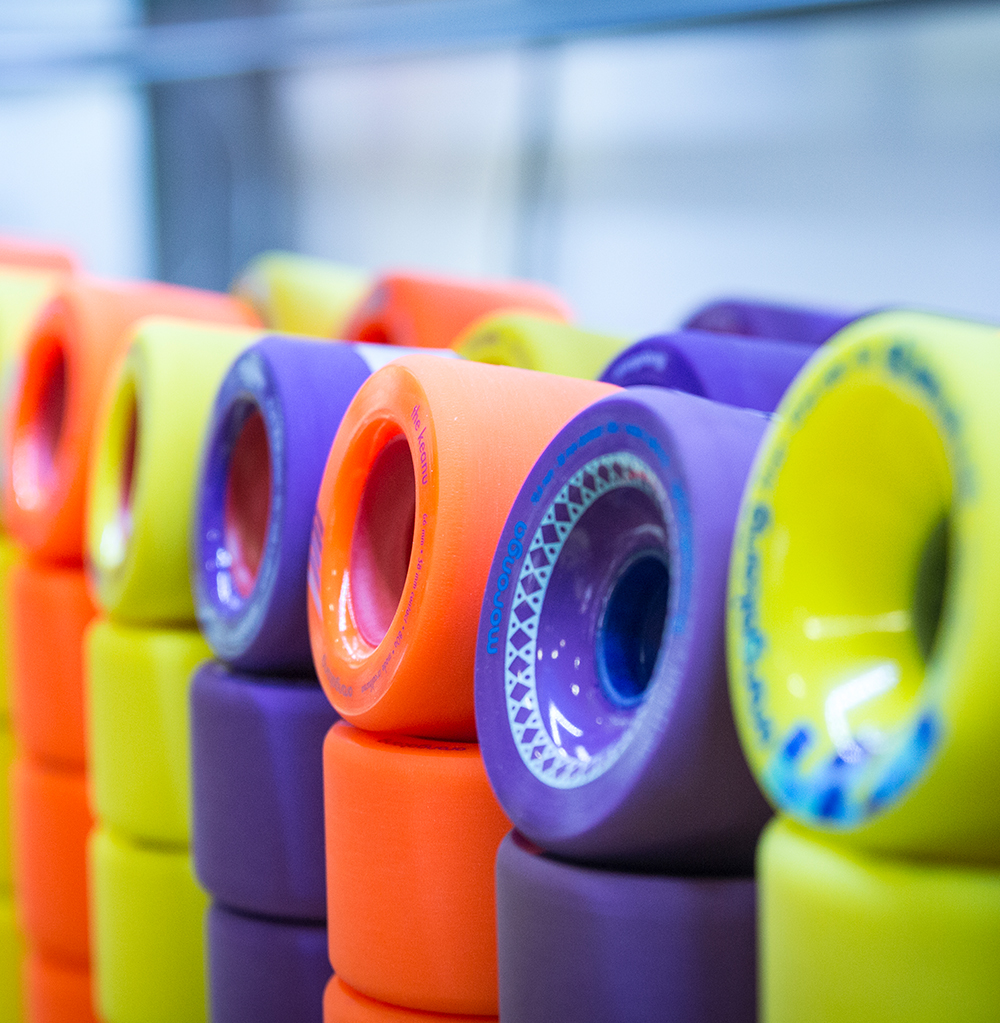
How to Choose Longboard Wheels: A Buyer’s Guide
When it comes to longboarding, it is always vital to take your longboard wheels into consideration. Ascertaining which wheels would be most suitable for your longboard skateboard should be one of your priorities since the kinds of wheels that you will use will have a dramatic impact on the types of rides that you will get.
Longboard wheels are typically made of polyurethane and come in various shapes, sizes, colors, and durability levels to suit your longboarding preferences. Longboards often make use of larger, softer wheels to provide a smoother ride on rough terrains, as compared to traditional shortboard skateboards that use smaller and harder wheels.
With the wide array of longboard wheels available in the market today, we understand that it can be quite confusing and overwhelming to make a decision on which longboard wheels to purchase. So, we have provided this comprehensive buyer’s guide to help you in your decision-making.
Let’s dig right in.
Longboard Wheel Size
The first factor you have to take into consideration when it comes to buying a longboard is the size of your longboard wheels. Most longboard wheels have a diameter of between 64 mm to 80 mm, with 70 mm being a common size. The lower the number in millimeters, the smaller the wheels. Larger wheels generally accelerate more slowly, although they roll more easily on cracks and debris at higher top speed. On the other hand, smaller wheels may accelerate faster, but they roll at a slower top speed. If your objective is to commute quickly and smoothly, big wheels are a good choice.
More than just the size, however, you have to consider whether the wheels of your choosing will fit on your longboard setup without causing wheelbite. If your longboard deck has large cut outs, it should be compatible with any wheel size. On the other hand, if your longboard deck does not have cut outs, you may have to add a riser pad that measures at least ¼” in order to accommodate wheels that are larger than 65 mm.
On average, a wheel size of 54 mm to 59 mm works best for beginners and bigger skaters who ride vert ramps, bowls, the streets, and skate parks. Meanwhile, specialty riders who skate longboards, downhill, old-school boards, and dirt boards use a wheel size of 60 mm or more. If you are uncertain which wheel size works for you, keep in mind that your height and weight can affect the wheel size that will feel right for your board.
Longboard Wheel Shape
As far as choosing the right set of longboard wheels goes, the shape of your wheels also plays a key role in ensuring that you don’t slip off during a downhill race but instead, catch the perfect turns and advance.
Here are the basics of longboard and skateboard wheel shapes:
Square Edge
Wheels with square-shaped edges are known for their grip even through fast corners. Hence, if you are a longboarder whose style demands constant contact with the ground (e.g., slalom, downhill), square-edged wheels must be your weapons of choice. Although they can also be used for slides, they are less forgiving than round-edged wheels.
Round Edge
If you wish to try carving and sliding on your longboard sometime, be sure to use wheels with round edges. They give your wheels less friction on paved roads, thus facilitating easy sliding, cruising, and freeriding. However, round-edged wheels do not grip the pavement as hard during turns.
Beveled Edge
Wheels with beveled edges are neither flat nor round at the edges. Instead, they are cut at one angle on the side, which gives you a contact patch on the edge of your wheel. This can be very handy when taking turns while bombing hills.
Longboard Wheel Hardness
How hard longboard wheels are is typically measured using a durometer scale. Harder wheels are generally faster while softer wheels are generally slower, although with better grip. Longboards normally require larger, softer wheels to give riders greater stability on a longboard’s long and spacious deck.
Most companies use the Durometer A scale to measure longboard wheel hardness, although there are also others that use the Durometer B scale. The lower the number on either scale, the softer the wheels. Most longboard wheels have a hardness that fall between 75A to 90A.
The following are some of the basic guidelines on measuring the hardness of longboard wheels:
78A to 87A
Soft wheels that are good for rough terrains or for boards that require lots of grip in order to roll over bumps and cracks with ease. Wheels that fall under these durometer ratings are designed for longboarding, hills, cruising, and smooth rides.
88A to 95A
Wheels that are slightly harder and slightly faster. They have a little less grip as compared to wheels from the previous range, but the grip is still good. Wheels with these durometer ratings are designed for riding on the street and on rough surfaces.
96A to 99A
Wheels with durometer ratings under this range are considered an all-around good wheel because they are capable of performing well at high speed without sacrificing their grip. These wheels are a great choice for beginner longboarders who skate the streets, skate parks, pools, ramps, and other smooth surfaces.
One of the important reasons why you should take durometer into consideration when choosing longboard wheels is that the hardness of your longboard wheel set can affect slide characteristics. Harder wheels are more durable and tend to glide across surfaces, so they will generally not slow you down but instead, will help you ride better. Softer wheels, meanwhile, are much easier to operate at faster speeds.
Longboard Wheel Cores
Cores support longboard wheels in giving riders smoother rides, as they help maintain the circular integrity of the wheels. Wheels with big cores will more likely remain spinning when sliding sideways compared to wheels that do not have a core.
How the core is positioned in wheels makes a huge difference on how the wheels grip, slide, and wear down. In fact, there are three core placement categories that longboard wheels share in common:
Centerset core
Wheels with centerset cores have their cores placed in the middle of the wheels at an equal distance to their outer edges. This has the advantage of making the wheels flippable in the event that you want to adjust the characteristics of your ride. It also promotes a longer wheel lifespan, as your weight load spreads evenly across the width of the wheels.
It is important to take note, however, that a centerset core position is not an ideal choice for producing good slides or creating maximum grip.
Offset core
Wheels with offset cores have their cores placed somewhere between the centerset and the sideset (that is, the core is slightly set in from the inside part of the wheel). This blend of the two characteristics allows riders to enjoy the best of both worlds, as it promotes versatility, accommodates various riding styles, and provides a nice balance of traction.
If your goal is to maximize your longboard grip, you can choose to flip your wheels inside out. However, you ought to know that this setup makes the wheels more difficult to control once they start sliding.
Sideset core
Wheels with sideset cores have their cores placed to the inside area of the wheels. Because it allows little to no inner edge, this core placement has the least amount of grip, and this makes it easier to initiate slides without exerting too much force.
Take note, however, that this provides riders with the least amount of grip, thus making slides more difficult to control and wearing the wheels down more quickly than you might be ready for. Nevertheless, sideset-cored wheels are still fun to ride and great for beginners learning how to break traction on their longboards.
Longboard Wheel Core Material
While longboard wheel core properties does not vary as much, the material used for the core of longboard wheels does have an impact on the quality and type of rides that you will enjoy, as well as on the longevity of your wheels.
Here is a quick list of some of the most common wheel core properties:
Aluminum
Aluminum has greater mass, which makes it perfect if you want to experience faster rides. It is also a stiff material that enhances wheel traction and wears down your wheels in a more gradual manner. The downside to this, however, is that it can be expensive.
Plastic
Plastic is slightly slower than aluminum but is also more lightweight. As one of the most inexpensive core material, it is most commonly used for longboard wheel core.
Urethane
The urethane formula used for longboard wheels is also an important factor to consider. Not all 78A wheels, for example, perform the same way, and their urethane formula commands just as much about the way that the wheels perform.
Companies use different urethane wheel formulae, with each formula having varying degrees of grip, ability to slide, and durability. Anyone who has ridden clay or steel longboard wheels would vouch for urethane wheels considering that the latter have better grip, increased speed, and an improved riding quality overall.
The best method of determining whether the urethane formula used in the longboard wheel suits you is to try several types of formula and just get a feel for your preferences. Fortunately, many companies nowadays have categorized their formulae as either downhill or freeride to make it easier for riders to choose. Freeride formulae generally slide easier and faster, although they have lesser grip and lesser durability than their downhill counterparts.
Longboard Wheel Contact Patch
Contact patches refer to the area of the longboard wheels that make constant contact with the pavement. This is an important feature of longboard performance because the larger the contact patch of the longboard wheel, the more distributed your weight will become over your longboard. This reduces the urethane compression in your wheels, lowers rolling resistance, and ensures quicker rides.
Conclusion
Now that we have covered the basics behind longboard wheels, you should now be able to make an informed decision on what to look for when choosing the right longboard wheels for your ride. Just make sure to consider the factors we have discussed above to get the most enjoyable ride that suits your longboarding preferences.

Leave a Reply